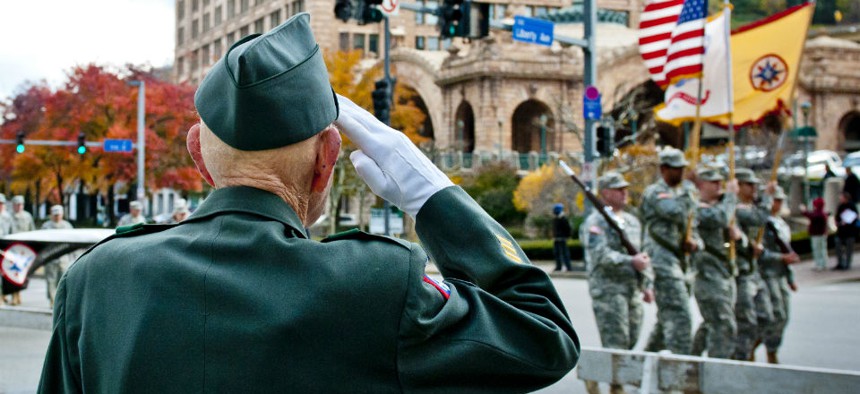
Retired Army 1st Sgt. William Staude, of Elliott, Pa., salutes the colors being carried by soldiers from the 316th Expeditionary Sustainment Command. U.S. Army
How Veterans’ Preference Laws Are Dragging Down Federal Hiring
‘Unwieldy’ and ‘convoluted’ laws are confusing vets and feds alike, report finds.
The federal government’s complicated and layered rules about hiring military veterans has created the perception of unfair and preferential treatment, which has in turn negatively impacted employee engagement, according to a new report.
The “patchwork of laws” that governs veterans’ preference hiring -- a concept that has existed in federal government for a century and a half -- was created with good intentions but has become too complex, the Merit Systems Protection Board found in an extensive review of the various policies. MSPB polling of federal employees revealed that 4.5 percent of workers said an official in their agency knowingly violated veterans’ preference laws, and 6.5 percent “inappropriately favored a veteran.”
The quasi-judicial agency noted its data demonstrated only perceptions, and not actual misconduct, but said the findings were significant as those opinions impacted the workplace. Four in 10 employees who said they witnessed veterans receiving inappropriate favorable treatment were not engaged with their work, while nearly half of those who saw a coworker knowingly violate veterans’ preference laws said the same.
Back when agencies used the “rule of three” -- which President Obama disallowed in 2010 but still exists in statute -- to fill vacancies, veterans received five or 10 extra points on their evaluation score, depending on their service and injuries sustained while on duty.
The arcane rules of veterans’ preference trace back to who qualifies as a veteran; the spouse, widow or mother of certain veterans are eligible for hiring preference. The mother of a veteran is defined as the former or current spouse of the father of the veteran, however. MSPB asked the Office of Personnel Management to explain that definition, but OPM was not able to offer a reason.
Since 2010, agencies have used “category ratings” when filling positions. That system does not use points, but instead groups applicants into categories such as “best qualified” and “well qualified.” Veterans automatically “float” to the top of the category to which they were assigned.
Further complications arise when agencies carve out special exceptions for veterans. Some positions allow veterans to erase age restrictions that may disqualify civilian applicants, while others are open only to veterans. If an agency opens a position internally, veterans’ preference does not apply, unless it is open to federal employees at multiple agencies. Some veterans have their preference eligibility expire, while others do not. The variety of rules and regulations increases the chances an employee or a veteran could perceive discrimination, MSPB said.
“There are so many factors about the person applying, the position for which he or she is applying, the authorities being used, and the agency in which the positions exist, that the system is beyond unwieldy,” MSPB wrote.
Adding to the confusion, only about one-third of new employees are hired using normal competitive examining. About 5 percent of external hires in fiscal 2010 were made using Veterans Recruitment Appointment, which allows agencies to fill a position with a veteran without competition.
Nearly half of all federal hires between 2000 and 2012 were made using excepted service, which allowed agencies to streamline the hiring process. Congress has enabled many agencies to use their own sets of rules for hiring and how to apply veterans’ preference.
MSPB specifically took issue with the Defense Department’s veterans’ hiring process. In the 1960s, Congress required a 180-day period between military members’ departure from service until they could be hired for a civilian Defense position. The buffer period existed to prevent the Pentagon from delaying the filling of positions until a particular service member retired from the military or even creating a position expressly for a soon-to-depart member of the military -- problems prevalent at the time.
The 180-day rule has been set aside since 2001, when a state of emergency was declared in response to the September 11th terrorist attacks. Since that time, Defense has hired more than 40,000 veterans for civilian positions in less than 180 days from when they left the military. More than one-third of them were hired while they were still on active duty.
MSPB said the ongoing state of emergency “has a real effect on a civil service law that was passed for the express purpose of fostering the health of the civil service.” It added 50 years after Congress created the law to prevent favoritism, “reports of the same problems persist.”
Overall, MSPB said agencies’ management should do a better job explaining the various veterans’ preference laws to their workforces to reduce the perception of impropriety. It noted, however, such an endeavor is easier said than done: “Of course, internal and external education would be easier if the rules were simpler.”
MSPB said veterans’ preference rules are “so convoluted” that a “rational person” could believe a manager was operating within the confines of the law when in fact he was not. While specific policy guidance on hiring practices falls outside MSPB’s purview, it advocated greater simplicity.
“If Congress chooses to examine hiring laws in the future,” MSPB wrote, “we recommend that it consider the benefits of creating a simpler system that would be easier to manage, apply, and explain to those who will be affected by the decisions made under that system.”







